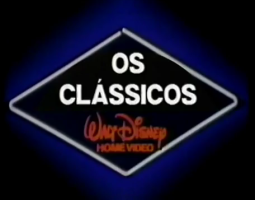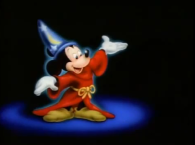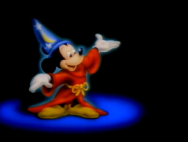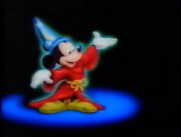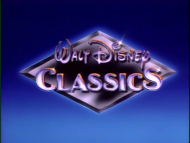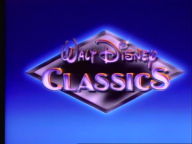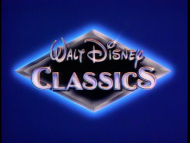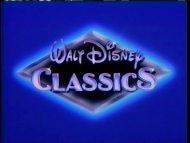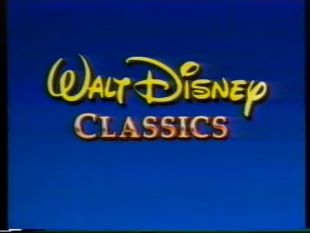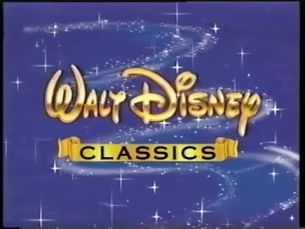Walt Disney Classics
Jump to navigation
Jump to search
Additional edits by VofDoom, TrickyMario7654 and Muzzarino
Background: "Walt Disney Classics" (nicknamed by Disney video collectors as the “Black Diamond Classics”) was created in 1984 to release the features from the Disney Animated Features canon. The first release from the line was Robin Hood in 1984, and more soon followed, including Pinocchio, Dumbo, The Sword in the Stone, Alice in Wonderland, and others, to great success. In 1990, due to the wild success of The Little Mermaid, the Classics line released that film to video and began releasing the more contemporary animated releases of the time from Disney. In 1994, after the video release of The Fox and the Hound, the Classics series was discontinued and replaced with a newer series, labeled as the Walt Disney Masterpiece Collection.
Background: "Walt Disney Classics" (nicknamed by Disney video collectors as the “Black Diamond Classics”) was created in 1984 to release the features from the Disney Animated Features canon. The first release from the line was Robin Hood in 1984, and more soon followed, including Pinocchio, Dumbo, The Sword in the Stone, Alice in Wonderland, and others, to great success. In 1990, due to the wild success of The Little Mermaid, the Classics line released that film to video and began releasing the more contemporary animated releases of the time from Disney. In 1994, after the video release of The Fox and the Hound, the Classics series was discontinued and replaced with a newer series, labeled as the Walt Disney Masterpiece Collection.
1st Logo
Logo: On a blue background, the text "WALT DiSNEY HOME VIDEO" (with "WALT DiSNEY" in its famous “signature” font created in the early 1960s), in red, swirls in from the upper-left corner of the screen, rotating clockwise as it does so, passes by quite close to the screen, then flips and begins cycling to the lower-left corner. A few seconds after the "WALT DiSNEY HOME VIDEO" text appears, “THE CLASSICS”, in a rather ugly white font, also comes from the upper-left side of the screen and begins slowly spinning, too, nearly following the same path as the WDHV text does. As this happens, the background begins to slowly “morph” into a large, blurry diamond shape on a black background. A large Prussian blue diamond then zooms in from the center of the screen at a slightly fast pace, before stopping at a huge size. As the diamond zooms up, “THE CLASSICS” flips over to the top of the diamond and settles there, while "WALT DiSNEY HOME VIDEO" lands on the bottom of the diamond. A white, simple diamond outline zooms out and plasters itself onto the edges of the diamond.
Variants:
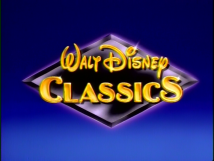
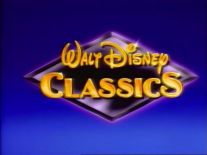
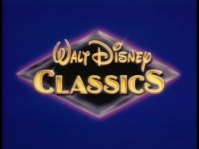
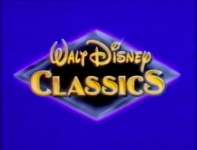
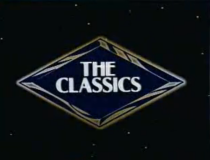
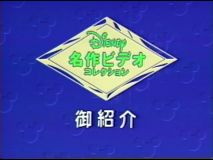
Nicknames: "The Black Diamond", "Sorcerer Mickey II", "Hi again, Mickey!", "Remake Diamond"
Logo: We start with the opening animation of the 1986 Walt Disney Home Video logo, with Mickey Mouse dressed in his Sorcerer’s Apprentice outfit like on Fantasia, standing on a blue spotlight on a black background. The camera slowly begins zooming up to his hand as the stars and crescent moon on his hat flash one-by-one, and then a magic spark flashes and appears above Mickey’s hand. We zoom past Mickey as the spark begins swirling around and begins to write "WALT DiSNEY" in the corporate Disney font, except it is metallic white. As we zoom out, the background begins to change to dark blue, and a black diamond with metallic edges fades in from a far point and begins to slowly zoom in, as “CLASSICS”, in a fancy metallic white Lo-Type font, begins zooming out from the bottom of the screen, before that and “WALT DiSNEY” settle on the diamond, which has zoomed up to a comfortable distance. The edges begin to glow white, and then a magic comet swishes into view from the bottom left of the screen, circles behind the diamond, then flies out from the top right and passes in front of the diamond before flying offscreen, leaving a trail of pixie dust that changes the "WALT DiSNEY CLASSICS" text to gold, and adds a purple tint to the diamond’s edges. The logo "shines".
Variants:
Logo: On a shady blue background, the words "WALT DiSNEY" are seen in yellow with a shadow effect. Below it is "CLASSICS" in a metallic orange serif font, also with the shadow effect. A light wipes over the logo from left to right.
(December 6, 1984-October 6, 1987, 1988, 1993)
<iframe frameborder="0" height="144" src="http://wikifoundrytools.com/wiki/closinglogos/widget/genericvideo/dc4c8f97fa766f58e9c4672e9b891b5a79dc93f6" width="258"></iframe><iframe frameborder="0" height="148" src="http://wikifoundrytools.com/wiki/closinglogos/widget/genericvideo/6e5c8d8fd385be8d15961ddb1ec1bb7807af07fb" width="264"></iframe><iframe frameborder="0" height="147" src="http://wikifoundrytools.com/wiki/closinglogos/widget/genericvideo/2ad7de2f5d00b365852154b98c8fc54e9f02f590" width="194"></iframe><iframe frameborder="0" height="148" src="http://wikifoundrytools.com/wiki/closinglogos/widget/genericvideo/ce763b047902f1824a628e1b0df072720358e063" width="265"></iframe>
NOTE: THE LOGO ON THE FIRST VIDEO STARTS AT 0:13.
Nicknames: "Cheesy Diamond", "Early Black Diamond", "Navy Blue Diamond", "Finest American Cheddar"
Logo: On a blue background, the text "WALT DiSNEY HOME VIDEO" (with "WALT DiSNEY" in its famous “signature” font created in the early 1960s), in red, swirls in from the upper-left corner of the screen, rotating clockwise as it does so, passes by quite close to the screen, then flips and begins cycling to the lower-left corner. A few seconds after the "WALT DiSNEY HOME VIDEO" text appears, “THE CLASSICS”, in a rather ugly white font, also comes from the upper-left side of the screen and begins slowly spinning, too, nearly following the same path as the WDHV text does. As this happens, the background begins to slowly “morph” into a large, blurry diamond shape on a black background. A large Prussian blue diamond then zooms in from the center of the screen at a slightly fast pace, before stopping at a huge size. As the diamond zooms up, “THE CLASSICS” flips over to the top of the diamond and settles there, while "WALT DiSNEY HOME VIDEO" lands on the bottom of the diamond. A white, simple diamond outline zooms out and plasters itself onto the edges of the diamond.
Variants:
- On some tapes, the logo stays onscreen for an extra ten seconds before finally fading out. This was most commonly seen around 1986, including Pinocchio, Dumbo and Alice in Wonderland, as well as later prints of the black clamshell release of The Sword in the Stone. It also appeared on the 1987 laserdisc releases of Sleeping Beauty and Pinocchio (both releases also have this variant paired up with the 1986 cut-short "presents" variant of the Walt Disney Home Video logo.
- Various Portuguese tapes have a still variant with the "THE CLASSICS" text replaced by "OS CLÁSSICOS". This was used at the beginning of a VHS promo for Bambi at the time.
- One scene on a rare promo sales tape for the 1984 VHS release of Robin Hood has the last few seconds of the logo where the diamond zooms in, but the background is black instead of blue. The glowing blue outline of the diamond from the background fades in after the logo is fully formed.
- On a 1984 demo VHS of Pinocchio, the logo has "PROPERTY OF W.D.T.N.T." (which stands for "Walt Disney Telecommunications and Non-Theatrical Company", the division that Walt Disney Home Video originally ran under until 1987) near the bottom of the screen, as with the rest of the tape.
FX/SFX: The swirling text, the background change, the zooming diamonds.
Music/Sounds: A bouncy, medieval-style synth-horn fanfare with a held-out synth-flute at the end. It sounds like it was produced on a Moog synthesizer.
Music/Sounds/Variant:
Music/Sounds: A bouncy, medieval-style synth-horn fanfare with a held-out synth-flute at the end. It sounds like it was produced on a Moog synthesizer.
Music/Sounds/Variant:
- At the beginning of the aforementioned Robin Hood promo sales tape, the logo is played at a slightly higher pitch.
- On a rare Disney promo sales tape from 1985 promoting the VHS release of Pinocchio, there's an announcer saying "The Disney Classics: Landmark animation made available for the first time from Walt Disney Home Video!"
Availability: Rare, as it was only used for a short period of time. Seen on 1984-1987 VHS and LaserDisc prints of Disney animated features including the original video releases of Pinocchio and Robin Hood. Usually it is in clamshell packaging (originally in big, black, heavy clamshells with the artwork printed directly onto the case, but switching over to the lightweight, white clamshells with removable inserts we are familiar with today in 1986), with the cover featuring a black flap on the lower right corner reading "The Original Animated Classic!", and often has the diamond print logo on the spine (without WDHV text) and on the videotape label (with WDHV text). The last video to officially use this logo was Lady and the Tramp. This logo has also been spotted on some post-1987 prints, including a 1993 reprint of The Sword in the Stone, and the mid-1988 demo tape of Cinderella. On black clamshell tapes of Dumbo, as well as very early prints of the black clamshell release of The Sword in the Stone and earlier prints of the mid-1986 slipcover release of Alice in Wonderland, the 1981 Neon Mickey logo shows up (the latter had the 1984 Classics logo replace the Neon Mickey logo on prints from circa late April 1986). Although the logo is seen on the cover, Australian releases do not use this logo; they use the 1986 "Sorcerer Mickey" logo or the 6th logo.
Editor's Note: A very primitive logo with cheesy computer effects, but still memorable amongst Disney fans and VHS collectors, and considered endearing because of its cheesiness.
2nd Logo
(October 4, 1988-September 21, 1994, February 28, 1996, 2003)
2nd Logo
(October 4, 1988-September 21, 1994, February 28, 1996, 2003)






<iframe frameborder="0" height="164" src="http://wikifoundrytools.com/wiki/closinglogos/widget/genericvideo/791242325e6aa70c3de406ea5918b67e550aa630" width="292"></iframe><iframe height="163" src="http://wikifoundrytools.com/wiki/closinglogos/widget/unknown/309a2b4e9cc2cfa4c4207135270fe61634320c94" width="204"></iframe><iframe height="163" src="http://wikifoundrytools.com/wiki/closinglogos/widget/unknown/ce88b023b7fb856f92be551e6385a56d5c8975c9" width="206"></iframe><iframe height="163" src="http://wikifoundrytools.com/wiki/closinglogos/widget/unknown/740f3bcdfa2eacd00d87165f0ec6de9e4f43ff57" width="209"></iframe>
Top: Sorcerer Mickey intro
Top Middle: The standard logos
Top Middle: The standard logos
Bottom Middle: Foreign logos
Nicknames: "The Black Diamond", "Sorcerer Mickey II", "Hi again, Mickey!", "Remake Diamond"
Logo: We start with the opening animation of the 1986 Walt Disney Home Video logo, with Mickey Mouse dressed in his Sorcerer’s Apprentice outfit like on Fantasia, standing on a blue spotlight on a black background. The camera slowly begins zooming up to his hand as the stars and crescent moon on his hat flash one-by-one, and then a magic spark flashes and appears above Mickey’s hand. We zoom past Mickey as the spark begins swirling around and begins to write "WALT DiSNEY" in the corporate Disney font, except it is metallic white. As we zoom out, the background begins to change to dark blue, and a black diamond with metallic edges fades in from a far point and begins to slowly zoom in, as “CLASSICS”, in a fancy metallic white Lo-Type font, begins zooming out from the bottom of the screen, before that and “WALT DiSNEY” settle on the diamond, which has zoomed up to a comfortable distance. The edges begin to glow white, and then a magic comet swishes into view from the bottom left of the screen, circles behind the diamond, then flies out from the top right and passes in front of the diamond before flying offscreen, leaving a trail of pixie dust that changes the "WALT DiSNEY CLASSICS" text to gold, and adds a purple tint to the diamond’s edges. The logo "shines".
Variants:
- In 1992, starting with 101 Dalmatians, the logo had brighter colors with the diamond in bright blueish-violet (possibly due to deterioration of the master), and the logo fades out earlier than before. Sometimes the logo begins abruptly (this mostly happened on 1992 releases).
- The original 1988 prototype version seen on Cinderella (retail copies only, demo tapes had the previous logo) had the background as a dark to light blue gradient, a more shiny, silver, metallic diamond, and rougher animation, and was also filmed, compared to the standard logo being videotaped. This has also been seen on the 1992 Laserdisc and demo/French Canadian VHS copies of The Rescuers, the later Canadian print of The Rescuers Down Under, a 1992 Descriptive Video Service VHS of Dumbo, the later Canadian/USA print of Robin Hood, the French Canadian VHS releases of Bambi, 101 Dalmatians and The Great Mouse Detective and the demo/French Canadian VHS copies of Beauty and the Beast. It also shows up at the beginning of the videotape Fantasia: The Making of a Masterpiece (which was included as part of a "Deluxe Collectors' Edition" box set of the movie). In most cases, the logo is off-center, with the diamond positioned further to the right, while Cinderella had the diamond centered properly. One of the last, if not the last video to feature this version of the logo, was the 1993 French-Canadian VHS release of Pinocchio.
- On several prints of the 1991 video releases of Robin Hood and The Brave Little Toaster, the Mickey scene is cut, and the logo starts off with the spark writing the words. This variant, shown before a preview for The Jungle Book, is accompanied with Brian Cummings saying, "Look for these animated Disney classics on videocassette." On the Robin Hood VHS, the same variant appears again before the film begins, but without the voice-over.
- On the 1991 video release of The Rescuers Down Under, just the end of the logo is shown before the Jungle Book trailer begins. There is no music and Brian Cummings says, "Don't miss this timeless Disney classic from Walt Disney Home Video."
- The shortened version seen on Robin Hood was also seen at the beginning of a UK promo for The Great Mouse Detective (ironically, this promo was found on the 1992 UK VHS release of Robin Hood, as well as on the UK video releases of The Prince and the Pauper, and The Legend of Sleepy Hollow), except in this version, the 1992 variant is used. Also, at the end of the logo, an announcer says "From Walt Disney Home Video", before cutting to the promo. On the US version of the promo, as seen on the 1992 prints of So Dear to My Heart and The Rescuers, the end of the 1992 variant is shown (with the music from The Great Mouse Detective playing in the background) and Mark Elliot provides the voice-over.
- The tail end of the 1989 variant (with the logo "shining") surprisingly appears at the beginning of a video promo for Bambi, as seen on several international Disney VHS releases (with the exception of the UK and Brazil).
- Japanese tapes from the late 1980s use a still variant for promos featuring the diamond reading "THE CLASSICS" on a starry sky with a thicker, more glass-like frame. This can be found on the 1988 Japanese VHS of Winnie the Pooh and the Blustery Day.
FX/SFX: All the animation in the logo.
Music/Sounds: A majestic, gradually rising synthesizer fanfare with a "sizzling" noise as the comet circles behind the diamond. Starting with the 1992 VHS release of The Rescuers, the music became distorted and heavier on bass possibly due to deterioration of the master recording.
Music/Sounds Variant: On the 1992 DVS VHS of Dumbo, a woman is heard saying "Now in animation, a figure appears. Mickey Mouse, wearing his red sorcerer's robe and tall blue pointed hat, stands with his left arm extended. A star shoots up from his palm, writing a signature and the logo 'Walt Disney Classics'."
Availability: Seen on 1988-1994 Disney video releases of their feature films with the text "A Walt Disney CLASSIC" or "Walt Disney's CLASSIC" on top and the diamond print logo on the clamshell spine.
Music/Sounds Variant: On the 1992 DVS VHS of Dumbo, a woman is heard saying "Now in animation, a figure appears. Mickey Mouse, wearing his red sorcerer's robe and tall blue pointed hat, stands with his left arm extended. A star shoots up from his palm, writing a signature and the logo 'Walt Disney Classics'."
Availability: Seen on 1988-1994 Disney video releases of their feature films with the text "A Walt Disney CLASSIC" or "Walt Disney's CLASSIC" on top and the diamond print logo on the clamshell spine.
- The first two releases with this logo, Cinderella and Bambi, feature the diamond print logo (with WDHV text) on a Betamax-sized sticker label like the last logo, though some later releases use an alternate sticker label instead of a white ink label (like some copies of The Little Mermaid, The Jungle Book, and The Rescuers Down Under).
- Also, the 1989 version of the logo was used on 1990 European VHS editions of Lady and the Tramp (including French, German, Italian, Swedish, and Finnish). Oddly enough, this was not shown on the French-Canadian release of Robin Hood.
- The last video to officially use this logo was The Fox and the Hound, while the last release overall to use this was the 1994 laserdisc of Aladdin (which was actually produced in 1993, but held over to September 1994 for piracy reasons), using the 1989 version.
- The most common Disney Classics tapes featuring this logo are the VHS releases of Beauty and the Beast and Aladdin (both with the muffled, bass-heavy music).
- The 1992 version of the logo with the original (clean) music only appeared on 101 Dalmatians (later copies) and The Great Mouse Detective.
- The 1992 version of the logo also appeared on an unofficial Bulgarian bootleg VHS of Pinocchio.
- Surprisingly, the 1989 version of this logo appears on early printings (from before December 18, 1995) of the 1996 Masterpiece Collection release of Pocahontas.
- This was not included on UK or Australian VHS releases from the early to mid-90's released under the label "Walt Disney Classics"; they just used the 1986 "Sorcerer Mickey" WDHV logo (and later, the "Disney Videos" logo, starting in 1995), which would also be used on Spanish-language tapes. However, the 1992 distorted variant made a surprise appearance (with the music at a higher pitch) on the 2003 UK VHS release of Pinocchio. The Classics laserdisc releases of Pinocchio, The Jungle Book, The Great Mouse Detective, and Beauty and the Beast also don't use this logo, instead using the aforementioned WDHV logo instead.
Editor's Note: A very well-made and professional logo that's a nostalgic favorite among many Disney fans and VHS collectors.
3rd (International) Logo
(1991-1996)
Nicknames: "The Wiping Light on Text"
Logo: On a shady blue background, the words "WALT DiSNEY" are seen in yellow with a shadow effect. Below it is "CLASSICS" in a metallic orange serif font, also with the shadow effect. A light wipes over the logo from left to right.
FX/SFX: The wiping light.
Music/Sounds: Opening of the promo following it.
Availability: Exclusive to the United Kingdom. Was seen on some WDC promos of the time, particularly Bambi.
Editor's Note: TBA
4th (International) Logo
(2000)
Nicknames: "Disney Glitter", "Walt Dust Classics", "Disney Magic Dust"
Logo: Same as the 1991 Walt Disney Home Video logo, except this time, the logo is placed over a purple background with swirly pixie dust. Instead of "HOME VIDEO", a golden banner with "CLASSICS" is seen. A thin orange light moves over various parts of the logo.
FX/SFX: The orange light.
Music/Sounds: See above.
Availability: Again, exclusive to UK. This was seen twice on a 2000 WDC promo seen on the 2000 VHS of Tarzan.
Editor's Note: TBA
